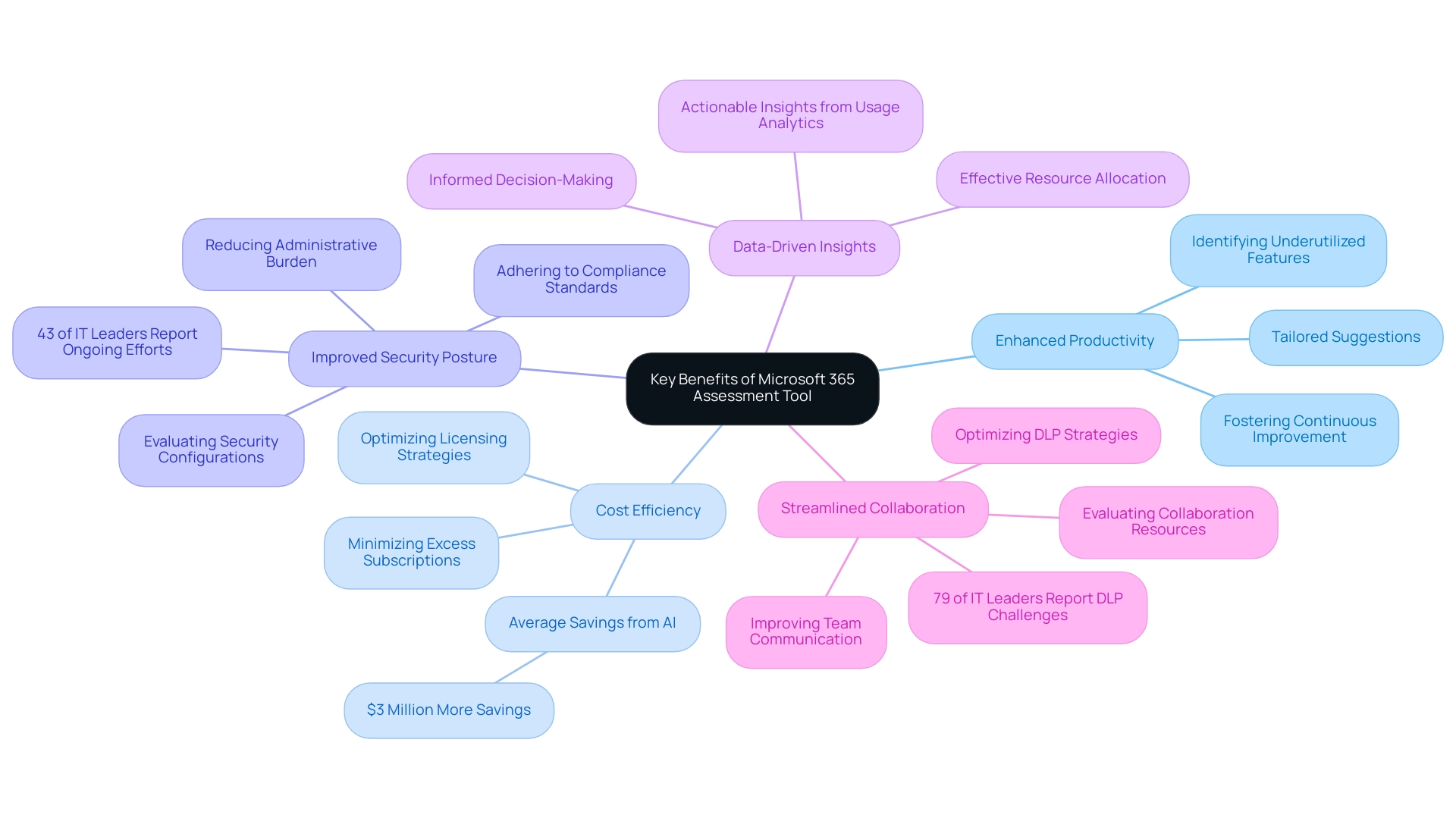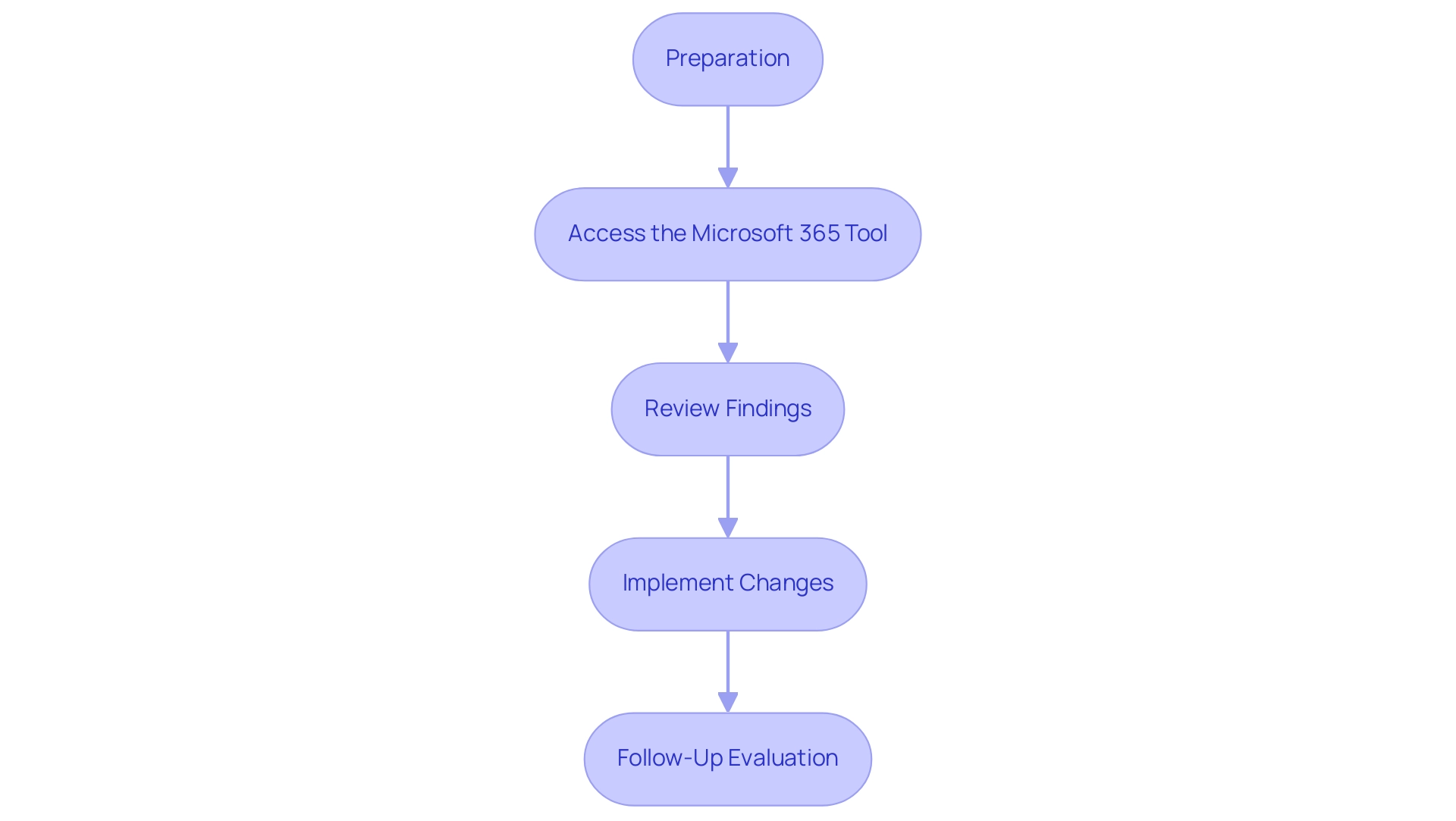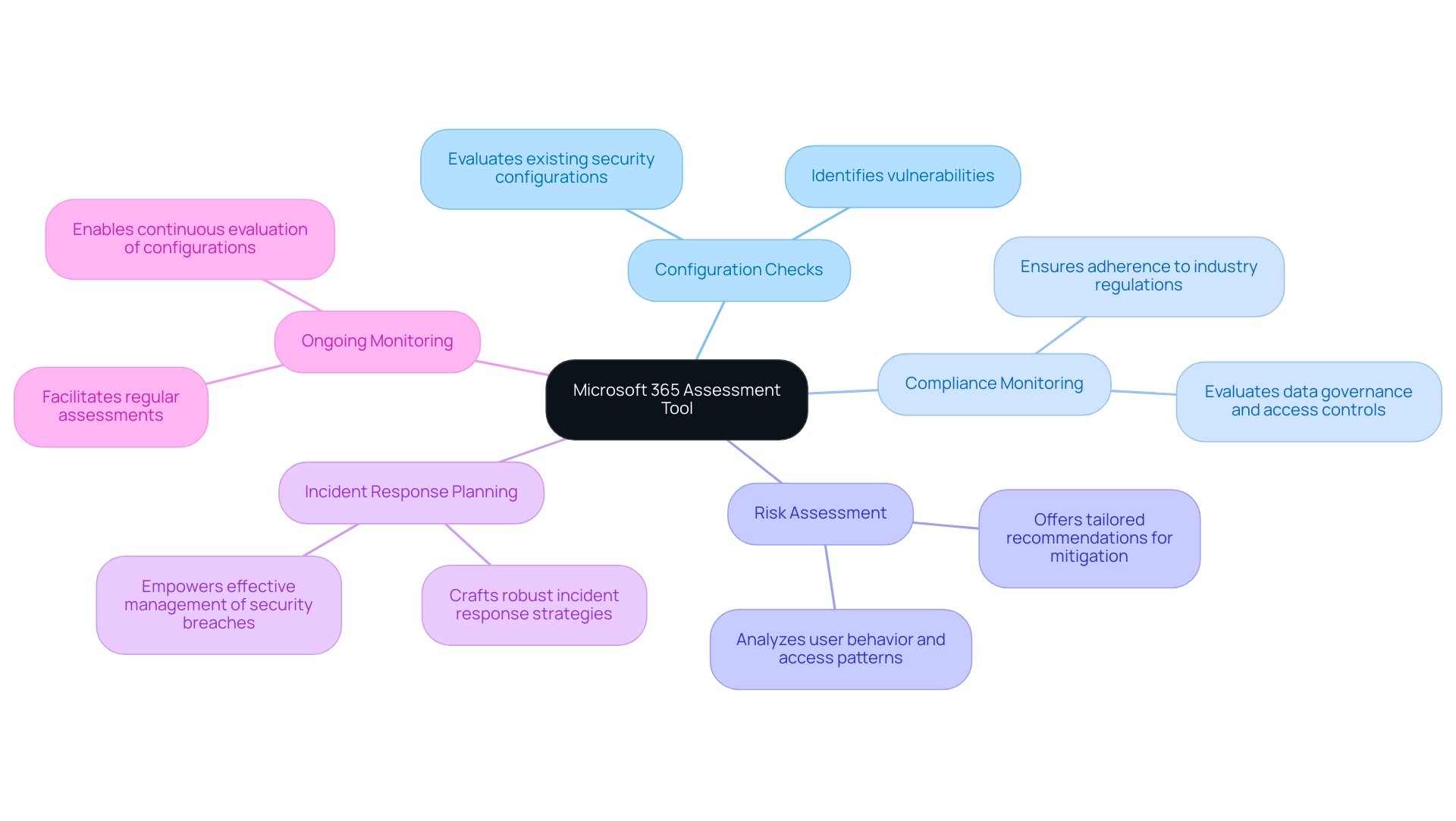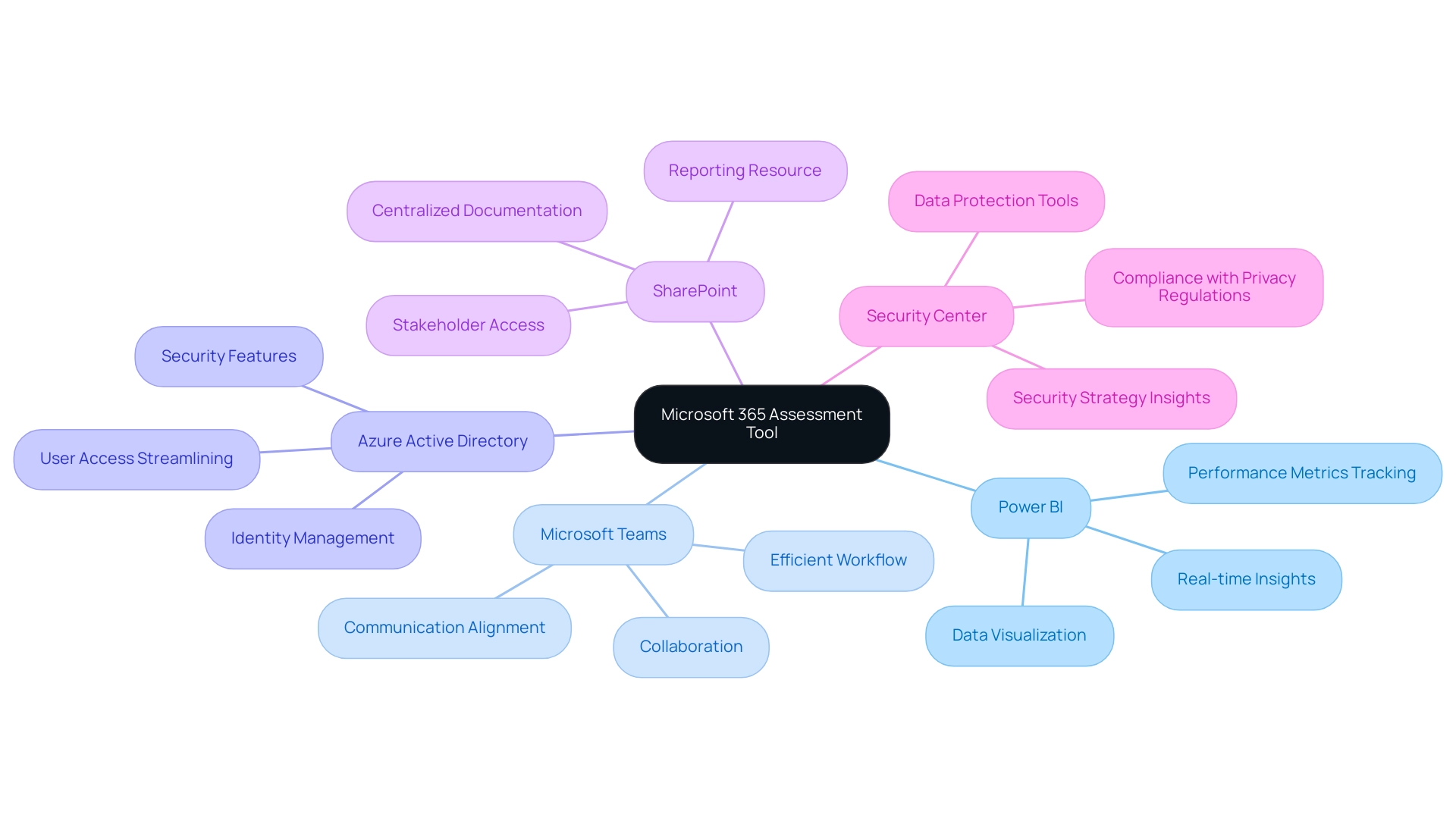Introduction
In the dynamic landscape of digital productivity, organizations are increasingly turning to tools that can unlock the full potential of their technology investments. The Microsoft 365 Assessment Tool stands out as a vital resource for businesses seeking to evaluate and optimize their use of Microsoft 365 services.
With a staggering number of daily active users, the need to understand usage patterns and enhance collaboration is more pressing than ever. This article delves into the multifaceted benefits of the assessment tool, detailing its ability to boost productivity, improve security, and streamline operations.
By providing actionable insights and tailored recommendations, the tool empowers organizations to make informed decisions that align with their strategic objectives. As the digital workspace continues to evolve, leveraging such tools becomes essential for maintaining a competitive edge and ensuring operational excellence.
Introduction to the Microsoft 365 Assessment Tool
The Microsoft 365 assessment tool serves as an essential resource for organizations aiming to evaluate and optimize their utilization of Microsoft 365 services. With over 958,333 daily active users engaging with the suite—spending 60% of their time on communications and 40% on creation applications like Word and PowerPoint—understanding usage patterns has never been more critical. This instrument enables businesses to conduct a thorough assessment of their current environment, uncover potential areas for enhancement, and develop strategies that bolster productivity and collaboration across teams.
By meticulously analyzing usage data and configurations, the Microsoft 365 assessment tool generates actionable insights that align with organizational objectives. Laura Iannini, a Cybersecurity Analyst, emphasizes the significance of the Microsoft 365 assessment tool, stating that it is essential in assisting organizations to utilize 365 efficiently. Additionally, Bharath, a certified engineer, highlights the resource's importance for small enterprises, ensuring they maximize their use of software effectively.
A practical illustration of this can be seen in the case study titled 'When to Use Template App vs. Usage Reports,' which highlights how Activity Reports serve as a starting point for understanding 365 usage, while the template app combines usage data with Active Directory information. This allows admins to visualize and analyze usage data, creating custom reports that further enhance productivity. In a landscape where optimizing technologies is paramount, the Microsoft 365 assessment tool stands out as a vital resource for any organization seeking to maximize its investment in 365.

Key Benefits of Utilizing the Microsoft 365 Assessment Tool
The 365 Assessment Tool delivers several critical advantages that can significantly transform organizational operations:
-
Enhanced Productivity: By identifying underutilized features and providing tailored suggestions, the application enables organizations to fully utilize their 365 investments. This approach not only boosts user efficiency but also fosters a culture of continuous improvement.
-
Cost Efficiency: Organizations can identify opportunities for cost reduction by optimizing their licensing strategies and minimizing excess subscriptions. This aspect is particularly crucial, given that firms leveraging AI and automation have reported saving, on average, $3 million more than those who have not embraced these technologies.
-
Improved Security Posture: The application meticulously evaluates security configurations, ensuring that organizations adhere to compliance standards and effectively safeguard sensitive data. This is vital in an environment where 43% of IT leaders report that maintaining security requires ongoing administrative effort. The Microsoft 365 assessment tool helps streamline these security processes, thereby reducing the administrative burden on IT teams.
-
Data-Driven Insights: Organizations benefit from actionable insights derived from usage analytics, facilitating informed decision-making regarding technology investments and strategic directions. This data-centric approach allows for more effective resource allocation and prioritization of initiatives.
-
Streamlined Collaboration: By evaluating the collaboration resources available within the 365 suite, the application improves team communication and workflow efficiency. This improvement is essential for fostering a collaborative environment, especially in light of the challenges reported by 79% of IT leaders regarding static email data loss prevention rules, which often fall short in preventing breaches. The 365 Assessment Resource addresses these challenges by optimizing DLP strategies, thereby enhancing data security.
Gabriel Karawani, Co-Founder of ClearPeople, emphasizes the importance of maximizing these resources, stating that organizations must leverage technology to drive productivity improvements and achieve cost efficiencies. Furthermore, the significant loss incurred by JPMorgan Chase due to an Excel error underscores the critical need for proper tool utilization and risk management. The comprehensive insights and recommendations provided by the Microsoft 365 assessment tool can significantly enhance operational effectiveness, making it an indispensable asset for organizations aiming to optimize their digital landscape.

How to Conduct an Assessment with the Microsoft 365 Tool
Conducting a Microsoft 365 assessment tool evaluation involves a systematic approach that ensures a thorough evaluation of your environment. The following steps outline the process:
-
Preparation: Begin by gathering essential data regarding your current 365 usage.
This includes details on user licenses, application configurations, and compliance requirements to create a comprehensive overview. -
Access the Microsoft 365 assessment tool: Log into the Microsoft 365 Assessment Resource via the Microsoft Admin Center, ensuring you possess the requisite permissions to utilize the resource effectively.
Run the Microsoft 365 assessment tool: Initiate the evaluation process using the Microsoft 365 assessment tool to analyze your environment and collect critical data on usage patterns and configurations.
Each identified office location will show a specific network evaluation value on its summary page, offering valuable insights into network performance. -
Review Findings: Upon completion of the Microsoft 365 assessment tool, examine the generated reports that highlight areas for improvement along with actionable recommendations tailored to your organization’s needs.
For instance, the Teams Calls and Meetings Analytics tool assesses network performance, focusing on issues like jitter, latency, and packet loss, helping to identify device usage, call ratios, and bandwidth pressures, particularly in anticipation of increased office demand. -
Implement Changes: Utilize the insights obtained from the Microsoft 365 assessment tool to prioritize and apply the recommended changes, thereby optimizing your Microsoft 365 environment.
The history feature enables users to review previous evaluations over the last 30 days and track metrics for up to two years, enhancing the ability to make data-driven decisions. -
Follow-Up Evaluation: Arrange routine follow-up evaluations with the Microsoft 365 assessment tool to track enhancements and guarantee ongoing optimization of your 365 deployment.
This iterative process is vital for maintaining a secure and efficient operational framework.
As Peter Vasey, Director of Modern Work at Nasstar, aptly states,
Real Time Communications are nearly always the first to surface a network performance issue, and whilst there are many considerations for meeting rooms and offices, the most important for call and meeting quality is to optimize your network.
This insight highlights the necessity of thorough evaluations and proactive network management in the context of 365. Additionally, consider utilizing CQD, which offers a free 30-day trial, allowing you to experience its benefits firsthand.

Ensuring Security with the Microsoft 365 Assessment Tool
Organizations aiming to fortify their security infrastructure find the Microsoft 365 Assessment Tool indispensable. Its key security features include:
- Configuration Checks: This feature conducts thorough evaluations of existing security configurations against established best practices, pinpointing vulnerabilities that may be susceptible to exploitation.
- Compliance Monitoring: The instrument aids organizations in upholding adherence to industry regulations by meticulously evaluating data governance and access controls, thereby reducing the risk of non-compliance.
- Risk Assessment: Through the analysis of user behavior and access patterns, the system identifies potential risks and offers tailored recommendations for mitigation, enhancing overall security posture.
- Incident Response Planning: Insights gained from the evaluation empower organizations to craft robust incident response strategies, equipping them to effectively manage potential security breaches.
- Ongoing Monitoring: The solution facilitates regular assessments that are crucial for sustaining a strong security posture, enabling organizations to continuously evaluate their configurations and compliance status.
As highlighted by Matt Smith, a solution architect for CoreView,
if CoreView finds a sign-in from an infected device in our report, you can link that to an audit report that shows that particular user and everything that they have accessed since that malware was detected.
This highlights the device's capability to not only identify vulnerabilities but also to provide actionable insights for remediation. Notably, CoreView oversees well over 7 million 365 endpoints, illustrating the tool's effectiveness in a large-scale environment.
Furthermore, a case study on the automation of security tasks demonstrates how the Microsoft 365 assessment tool can help streamline processes and reduce risks, freeing up time for security teams. Additionally, recent news about a misconfiguration in Azure Blob Storage service, which exposed the personal data of over 548,000 users, highlights the critical need for robust security measures and compliance monitoring, reinforcing the relevance of the 365 Assessment Tool in preventing such incidents. Consistent monitoring through the Microsoft 365 assessment tool has been shown to significantly enhance compliance rates across organizations, thereby safeguarding sensitive data and reinforcing trust.

Integrating the Microsoft 365 Assessment Tool with Other Microsoft Services
The robust integration capabilities of the Microsoft 365 Assessment Tool with various Microsoft services significantly enhance its functionality.
-
Power BI: By utilizing Power BI, organizations can effectively visualize evaluation data, crafting dashboards that track progress and performance metrics. This integration not only supports data interpretation but also permits real-time insights into the evaluation process.
-
Microsoft Teams: Utilizing Microsoft Teams enables smooth cooperation among team members involved in the evaluation process. This ensures consistent alignment and communication, fostering a more cohesive and efficient workflow.
-
Azure Active Directory: Integration with Azure Active Directory (AD) enhances identity management and security features. This streamlines user access and permissions, reinforcing the security framework essential for managing sensitive information.
-
SharePoint: SharePoint functions as an essential resource for documentation and reporting. By maintaining a centralized repository for evaluation findings and action plans, it ensures that all stakeholders have access to the necessary information, promoting transparency and accountability.
-
Security Center: Insights gathered from the evaluation resource can inform security strategies, ultimately enhancing the overall organizational security posture. This proactive approach is crucial in navigating today’s complex security landscape while ensuring compliance with privacy regulations, as demonstrated by the case study on protecting Power BI data with Purview. This case study illustrates how Purview Information Protection and Defender for Cloud Apps provide tools to control data visibility and apply sensitivity labels across Office applications, ensuring compliance and preventing exposure of sensitive data.
To further support organizations looking to implement these integrations, it’s important to note that you can submit a request for a specialist or partner to contact you within two business days. As highlighted by Gartner, Microsoft was positioned highest for Ability to Execute and furthest for Completeness of Vision in the June 2024 Gartner® Magic Quadrant™ for Analytics and Business Intelligence Platforms. Such integrations not only enhance operational efficiency but also position organizations to better manage and protect their data assets.

Conclusion
The Microsoft 365 Assessment Tool emerges as an indispensable asset for organizations striving to optimize their use of Microsoft 365 services. By facilitating a comprehensive evaluation of current usage patterns and configurations, the tool empowers businesses to identify opportunities for enhanced productivity, cost efficiency, and security. Through actionable insights and tailored recommendations, organizations can not only streamline operations but also foster a culture of continuous improvement.
The benefits of utilizing the Microsoft 365 Assessment Tool are manifold:
- Enhanced productivity is achieved by uncovering underutilized features.
- Cost efficiency is realized through optimized licensing strategies.
- The tool plays a critical role in strengthening the security posture of organizations by ensuring compliance with industry regulations and identifying potential vulnerabilities.
This comprehensive approach to assessment not only aids in effective resource allocation but also enhances collaboration among teams.
In conclusion, as the digital landscape continues to evolve, the importance of leveraging tools like the Microsoft 365 Assessment Tool cannot be overstated. Organizations that embrace this resource are better positioned to maximize their technology investments, enhance operational effectiveness, and maintain a competitive edge in their respective markets. By prioritizing a systematic assessment of their Microsoft 365 environment, businesses can ensure they are not merely keeping pace with change but actively driving it.




